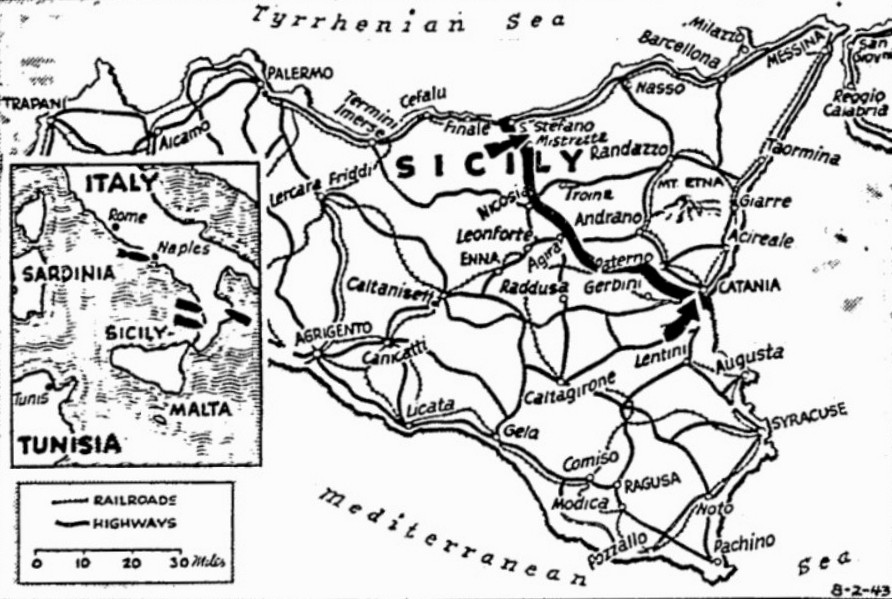The Pittsburgh Press (August 2, 1943)
ALLIES OPEN DRIVE FOR KNOCKOUT IN SICILY
San Stefano falls in push along coast
10,000 prisoners, half of them Nazis, taken by Americans
Gains in air, on land and sea were scored by Allied forces in Sicily and Italy, with British and U.S. planes and warships striking at Italian cities and shelling the coasts. In Sicily, Americans captured San Stefano in the drive on Messina while the British 8th Army deepened its bridgehead before Catania. U.S. planes bombed Naples, and British warships struck at two places on the top of the Italian toe and one point on the sole (inset map).
Allied HQ, North Africa (UP) –
Allied armies have launched an offensive to crush Axis resistance in northeastern Sicily, smashing forward on the entire Messina bridgehead front of more than 60 miles despite strong enemy opposition.
An official announcement said that “Allied forces in Sicily have started an offensive,” with the U.S. 7th Army under Lt. Gen. George S. Patton Jr., capturing 10,000 more prisoners – half of them Germans – and driving 12 miles into the enemy’s northern flank. The north coastal town of San Stefano and the town of Mistretta, six miles south of San Stefano, fell to the Americans, as did Castel di Lucio, Castel di Tusa and Matta Pettino.
Reports steady progress
Today’s communiqué reported steady progress on all sectors despite strong counterattacks, which were repulsed.
The communiqué said:
Assoro, Nissoria, Nicosia, Mistretta and San Stefano are in our hands.
The network of roads in enemy hands was greatly reduced by the new advances and the remaining roads are being pounded day and night by Allied airplanes.
The latest bag of Axis prisoners increased to about 87,000 the number of Axis troops taken during the entire Sicilian campaign.
Crushes counterattack
The famous British 8th Army, veteran of El Alamein and Mareth in Africa, crushed a strong Axis counterattack on the southern side of the Mt. Etna Line, and Canadian troops pushed forward in heavy fighting to the south of the American columns.
Gen. Sir Bernard L. Montgomery, commander of the 8th Army, told his troops that “we will now drive the Germans out of Sicily,” and praised the Americans for seizing “more than half of the island in record time.”
Axis losses high
Axis losses on all fronts were reported heavy. The heaviest fighting was said to have taken place in the Assoro and Nissoria areas of central Sicily. There the Canadians faced the toughest German motorized elements in a difficult mountainous region where the Axis was contesting bitterly for every foot of ground.
The new American drive gave the 7th Army possession of the last important north-south road held by the Axis leading to the central part of the island. The road runs south from San Stefano through Mistretta and the Caronia Mountains to Nicosia.
The American advance of 12 miles brought the 7th Army within 70 miles of Messina along the north coastal road.
